How to Onboard New Customers
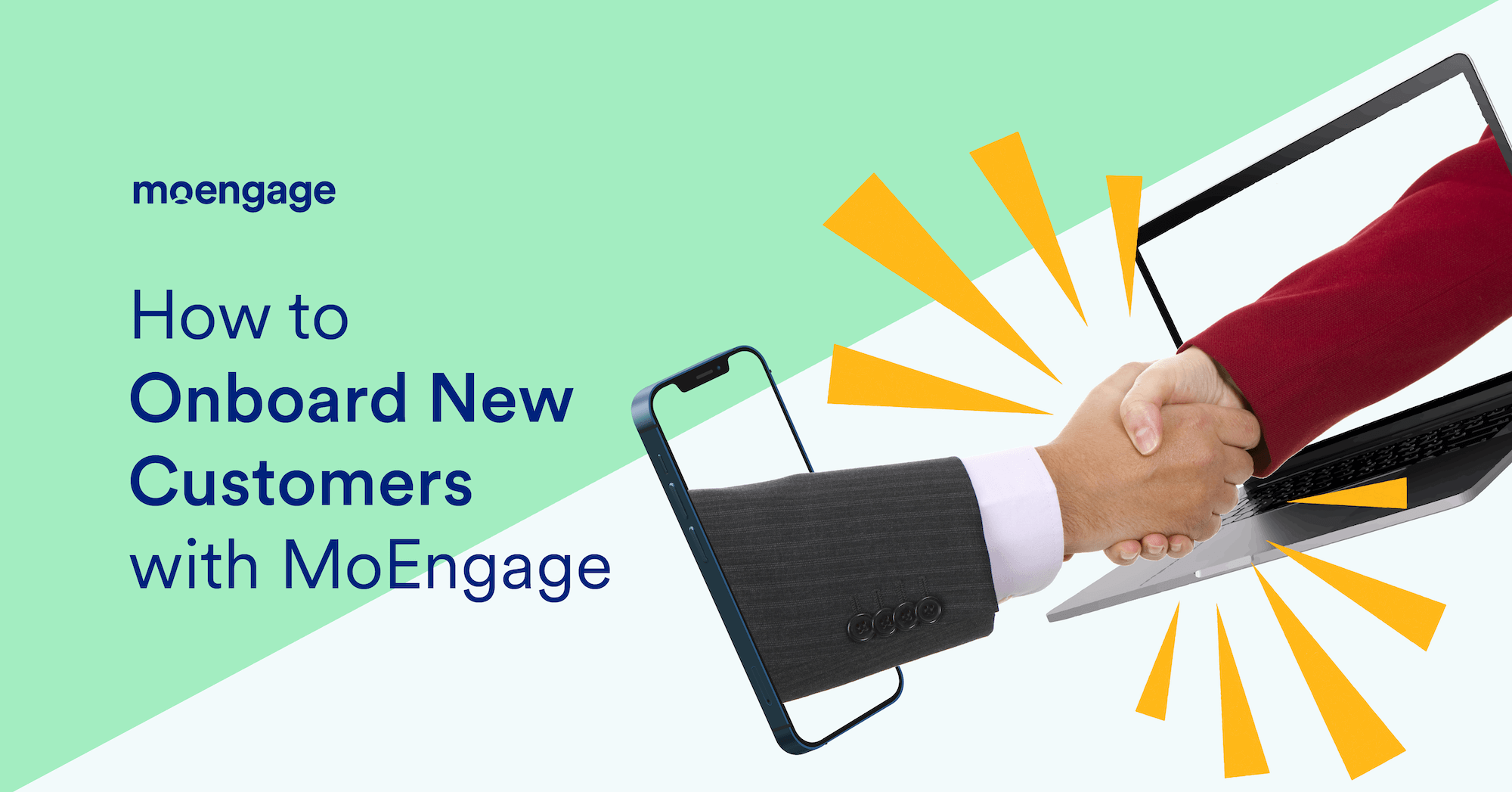
Reading Time: 9 minutes
I am Ausesh Mitra, the Customer Success Manager at MoEngage.
As a part of my job, I’ve seen brands painstakingly work on marketing campaigns and convert leads into paid customers. They have mastered the art of customer acquisition. However, brands face challenges in retaining these hard-earned customers. The leaky bucket is a common problem across industries and regions.
75% of customers who download an app or use a product drop off within the first week.
The reason is poor customer onboarding or lack of awareness around onboarding new customers.
Customer onboarding is the first and crucial stage of the customer’s journey where you gain trust and fulfill your customers’ expectations. It is the first step to successful customer retention. Brands must, therefore, not undermine its significance and pay attention to improving it.
However, most customer onboarding processes are fragmented, or the experiences across different touchpoints are inconsistent. This frustrates customers and eventually leads to drop-offs.
That’s why I’ve developed a comprehensive guide on onboarding customers successfully. The guide covers the steps to onboard customers, best practices, and making the process efficient.
I hope it helps you design and implement an effective customer onboarding strategy for your brand.
What is Customer Onboarding?
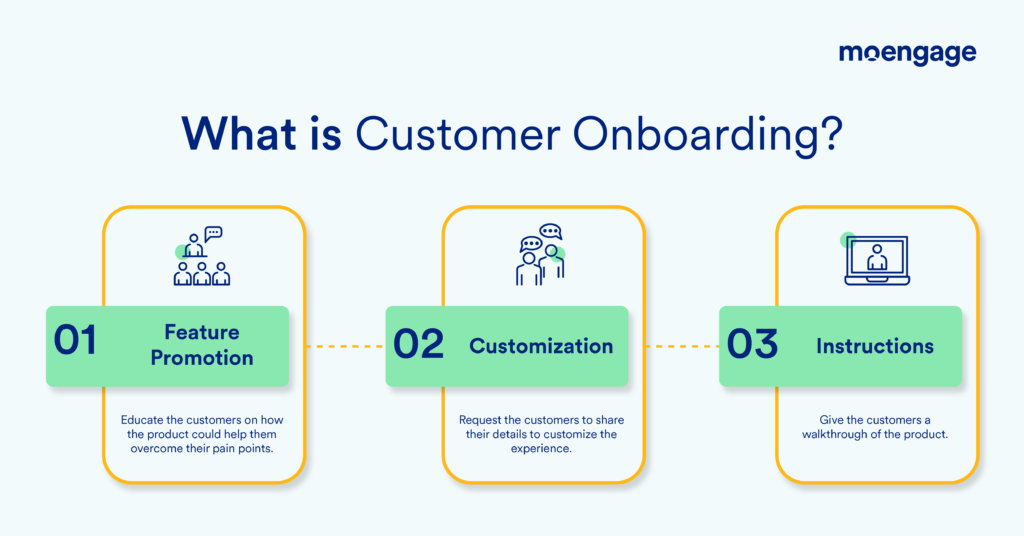
Imagine if you had to navigate a new city without a map or travel directions! That’s how your customers might feel when they sign up on a new website or app. Customer onboarding involves nurturing and helping these new customers get acquainted with your product. According to Nielsen Norman Group1, there are three critical components to the onboarding process:
- Feature promotion: Educate customers on how the product could help them overcome their pain points.
- Customization: Request customers to share their details to customize the experience.
- Instructions: Give customers a walkthrough of the product.
You can make all or one of them a part of the onboarding process. It sets the tone for future interactions.
Why is Customer Onboarding Important?
8 out of 102 customers admit that they deleted an app if they didn’t know how to use it! That’s why customer experience is so critical. Customer onboarding helps in:
1. Boosting Customer Lifetime Value (LTV)
Customer retention is as necessary as acquisition in any business model.
According to the Pareto principle, 80% of the revenue comes from 20% of your customers. A seamless and positive onboarding experience will help you connect with customers and improve the customer lifecycle.
2. Reducing Churn
According to our survey, over 56%3 of the customers uninstall the app within the first seven days of using it. 23% uninstall within 24 hours. This happens when customers don’t understand how the app benefits them. A strong onboarding strategy will help customers understand the app’s value and encourage them to use it more actively.
3. Reaching Out to More Customers
Referral leads convert 30%4 better than leads generated from other marketing channels. Consumers trust recommendations from friends and families, and happy customers will always recommend the products they love to others. A good onboarding process will delight the new customers and lead to referrals if it meets their expectations.
4. Increasing Revenue
According to McKinsey’s research, on a 10-point Net Promoter Score (NPS) scale, every one-point increase in customer onboarding satisfaction led to a 3% increase in revenue5.
An effective customer onboarding process will encourage the customers to use the product and make their first purchase. You can also cross-sell or upsell products or services to generate more revenue and generate valuable feedback to improve your overall product.
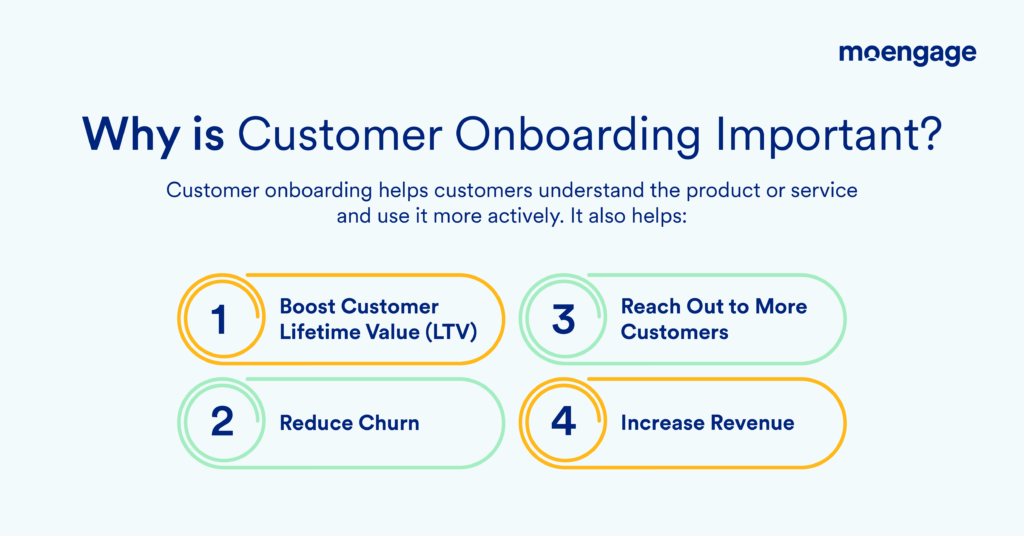
How Can You Onboard New Customers?
Here are a few ways to build a successful onboarding process and integrate it into your sales process:
Step 1: Build a Customer Onboarding Strategy
The first step in the onboarding phase is to determine the onboarding goal.
What actions do you want the customer to do?
What channels will you use to reach out to the new customer, and how frequently will you communicate?
Answering these questions will help you plan the strategy and setup process.
Step 2: Create an Onboarding Workflow
You will lose valuable customers if the onboarding process is complicated or creates friction. The customer should be able to understand your product and adopt it quickly. An onboarding flow can help you achieve that. It will enable you to create a seamless customer experience and engage them long-term. It will also help you create a customer set and plan communication based on different triggers.
Step 3: Ask for Permission to Use Data
Data is vital to personalize experiences. However, data privacy laws require you to ask customers for permission to use their data. Explain the purpose of collecting and collecting only essential data that will help you improve an onboarded customer experience.
Step 4: Engage Across Channels
Customers interact with brands across different channels such as emails, social media platforms, websites, in-store, etc. Use push notifications, emails, SMS, and other channels, and stitch them together to create a seamless experience.
Step 5: Show Progress
Lengthy processes can lead to early drop-offs in the customer journey. A progress bar could display the progress and motivate new customers to complete the process.
Step 6: Measure, Test, and Iterate
Revisit your onboarding process regularly. Measure the efficiency of the process, experiment with different styles such as gamification, or make micro-changes such as a change in button colors or replacing images on the welcome screen. Keep iterating to make onboarding a success.
How Can You Onboard New Customers with MoEngage?
Whenever a customer installs a mobile application, the next action is to sign up with the app.
However, often, customers can be skeptical about the sign-up process for multiple reasons –
Will it benefit them?
Will it be just another inactive app?
Will they be bombarded with irrelevant push notifications?
With the millions of apps already available, the onboarding process needs to be simple, free of cost, and provide just enough nudge.
MoEngage Channels For Onboarding Process
Push Notifications: Craft beautiful push messages and send them to your customer as soon as they log in to the app.
In-app: Use in-app messaging to build deeper customer relationships. Use this feature to ask about their preferences and help them discover more value in your product.
Onsite Messaging: Leverage onsite messaging and deliver messages that drive conversions.
Facebook Audience: Nudge your customers towards a purchasing decision with Facebook Audience targeting.
Note: You can also use the Facebook Audiences feature to solve customer churn and bring your brand back into the customer’s mind-space.
Additional Features to Up Your Onboarding Process
The benefit of using MoEngage for customer onboarding does not stop with the above features. To keep your customers engaged, you can also use the features listed below:
Flows: Use MoEngage Flows, a drag and drop feature that lets you orchestrate messaging according to your business model, customer preferences, and industry best practices.
Push Amplification™: Improve your push notification delivery rates with Push AmplificationTM Plus. Measure your onboarding notification delivery rates and optimize your marketing strategy accordingly.
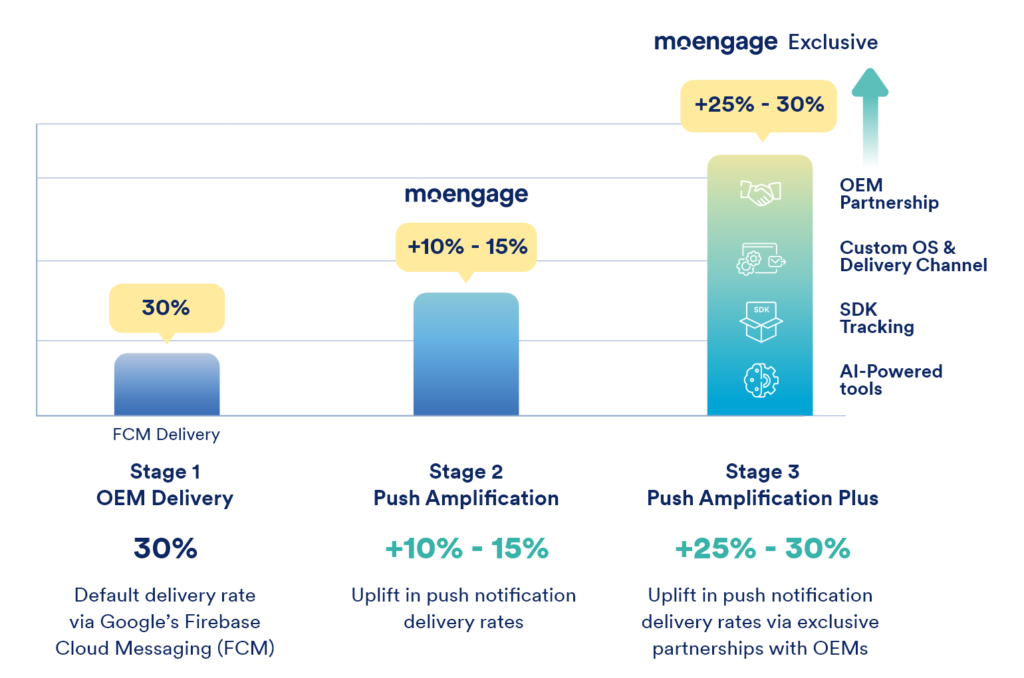
Push Templates: Lastly, use the push notification templates to engage and offer personalized notifications to new customers.
What Are the Best Practices for the Customer Onboarding Process?
Here are some best practices for a successful customer onboarding process:
1. Prioritize Customer Onboarding Experience
Successful brands always focus on creating a positive experience.
Govind Kavaturi, the former director of partnerships and operations at Branch, shared tips6 on creating the best customer experiences.
- Keep the interface clean, eliminate information overload, and simplify the messages.
- Give customers the flexibility to access your product from any device or platform without friction.
- Let the customer feel in control while using the product. Calm, for instance, allows customers to choose their goals on the app’s first screen and tailors the rest of the process accordingly.
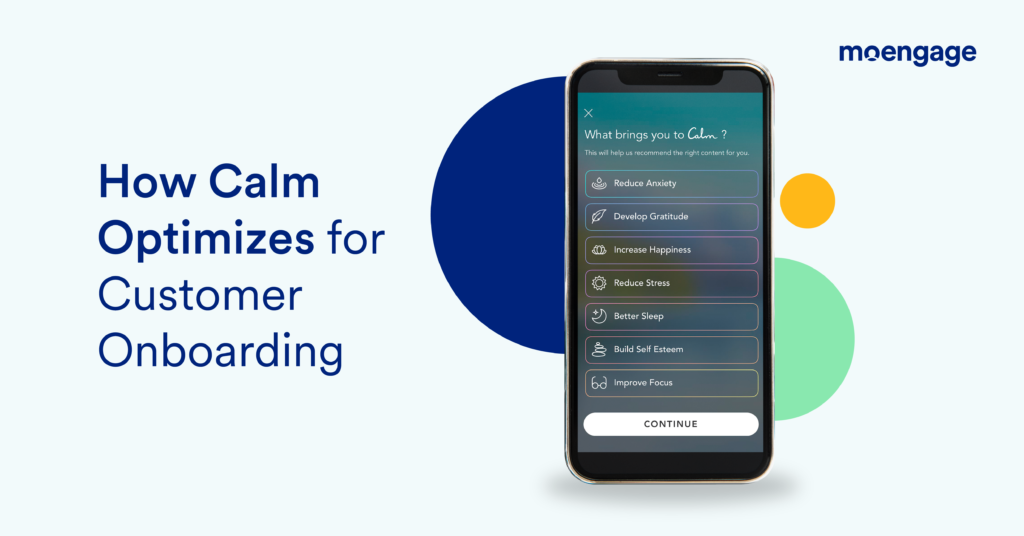
2. Create Micro-moments
Create several micro-moments throughout the customer journey to make it memorable. Follow these three steps to design memorable micro-moments.
- Simplifying the registration process: A one-click sign-in with an existing account such as Gmail, Facebook, or Apple ID can save customers’ time and accelerate the sign-up process.
- Single sign-on across all devices: Allow customers to access your product automatically from any device without entering the login details every time.
- Provide the first-share option: Allow customers to share their experience across all platforms when they use the product for the first time.
3. Train Your Employees
Customer onboarding should be consistent across all touchpoints, including social media, in-store interactions, and customer support.
Provide specialized training to every team member to understand the customer’s pain point and address it efficiently. Ensure that everybody is trained on the workflow and updated if any changes occur. Customer satisfaction is crucial for customer success.
4. Personalize the Customer Experience
Gather data about the new customer, such as their needs, preferences, pain points, and other details to personalize their experience.
For example, a fintech app could share a personalized knowledge base or tailor the product tour based on the customer’s financial portfolio and investment preferences. Customized experiences will help the customer understand the product better and make purchases.
5. Deliver Value Consistently
Happy customers are a valuable asset to your brand. Make them happy by delivering more value consistently. Build an ongoing relationship with existing customers by informing them about new product updates and sharing the knowledge base. Gather customer feedback, be responsive, and answer their queries on time.
How to Measure a Successful Onboarding Process?
Measure the customer onboarding process for customer success. Here are a few customer onboarding metrics that can help you identify friction points and measure your program’s success.
Engagement Rate
It measures the percentage of consumers from a cohort who actively use the product over time. Typically, brands measure the engagement rate 30/60/90 days after the app installation. If the customers are inactive within the first week, relook into your strategy. Make the process simple and effective and measure the engagement rate to determine if it needs further improvement.
Free Trial to Conversion Rates
A paying customer is essential for the business’s growth. This is important because it measures how many free trial customers have converted to paid customers. If the numbers are low, it means that the customers have not understood your product well or do not find it helpful. Improving the onboarding workflow could help you achieve the goal. Use options such as in-app messaging to explain your product’s value to the customer. Show them how they could benefit from the paid subscription and gently nudge them with push notifications and reminders to convert them into paid customers.
Support Tickets Per Day
These tickets indicate the total number of customers requesting help to complete onboarding. The onboarding is complex if the number of tickets per day is high.
Build a self-service portal with all updated resources on using the product. Make the process more intuitive and simpler for the customer to complete without assistance. Use A/B testing to know which strategy works better for your business.
You can also use other important metrics, such as product adoption and customer response rates, to create measurable milestones and achieve the desired outcome.
How to Improve Customer Onboarding?
Here are some helpful tips for successfully onboarding customers.
Use Flows
Smart workflows can help you create a stellar campaign.
Let’s take a business scenario of leading a customer to make the first purchase. You can set a trigger to add the customer details to the database as soon as they submit their details. You can build a workflow to send an automated welcome email to the customer to sign up and follow-up emails in a planned manner with videos, guides, and helpful tips if they have not completed the action. Customer onboarding occurs smoothly when the campaigns are automated with workflows.
Lifestyle used MoEngage’s dynamic engagement strategy, a marketing automation platform, to perform the RFM analysis, create personalized smart-triggered campaigns, and drive conversions. The fashion brand improved retention by 30% and boosted conversions by 4x.
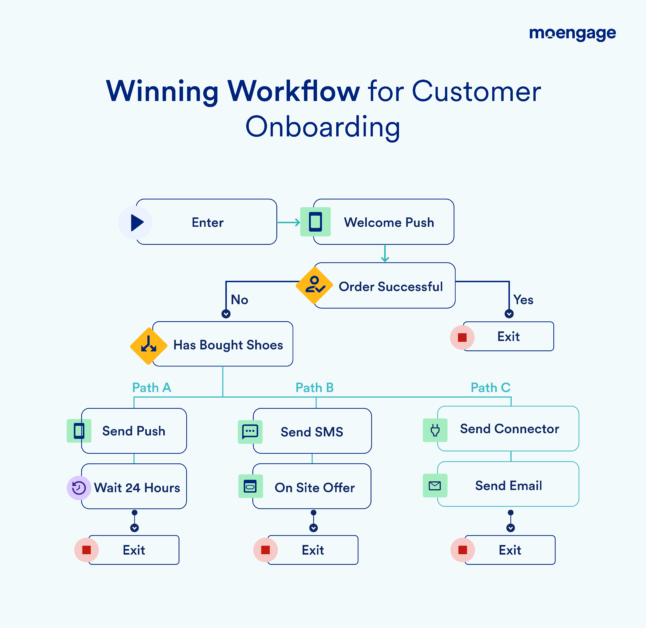
Explain the Value Proposition
You have just 50 milliseconds to establish a connection with the customer. Take this opportunity to explain your product’s advantages. Talk about the value of your product in one line on the welcome page or enlist the core features that could benefit the customer. Peet, for instance, highlights its core features during the new customer onboarding process.
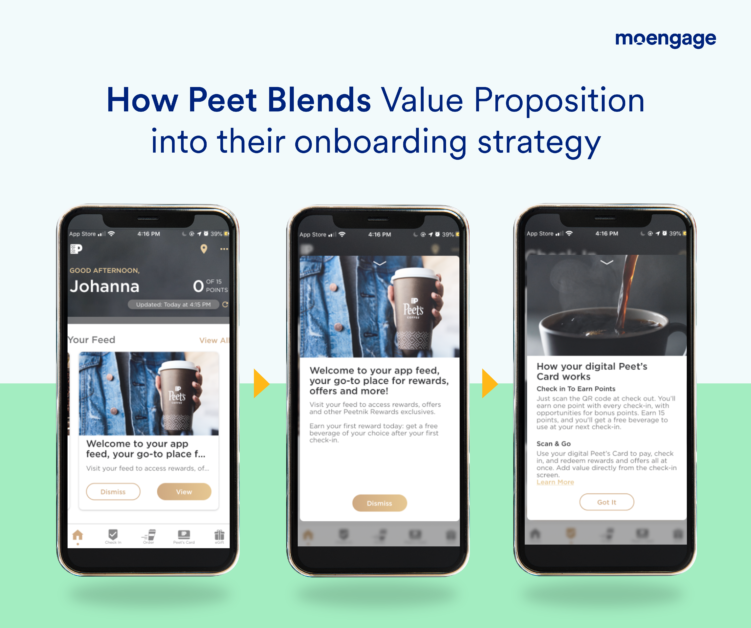
Optimize the Onboarding Process
Always measure the onboarding process metrics and optimize them according to best practices.
Take the example of Avail, a fintech app that allows blue-collar workers in India to avail of loans. Avail understood its ideal customers well and optimized the process accordingly. They provided audio instructions on the sign-up page explaining why the customer must fill in specific fields and why Avail collected their details. They replaced the search option with company logos as the customers struggled to spell their employer’s name correctly. They also designed a clutter-free interface and provided manual support to ~90% of the customers.
Customer onboarding is a make-or-break situation for your brand. Make the most of this opportunity to deliver a successful onboarding experience to your customers.
What’s Next?
- Sharpen your expertise in customer onboarding with our #GROWTH Academy foundation course.
- Take a look at customer onboarding flows and processes for e-commerce.
- Download these updated customer onboarding strategies for banking.
- Find winning strategies to collect customer feedback.
- Connect with an expert for a detailed discussion about your challenges to new customer onboarding.













